Sustainable Development Benefits of Waste Management in Asia-Pacific
VerifiedAdded on 2023/01/19
|11
|2184
|27
Report
AI Summary
This report examines the pressing issue of solid waste management in the Asia-Pacific region, particularly in developing countries and secondary cities. It highlights the challenges posed by increasing urbanization, inadequate waste collection, and the environmental and health risks associated with improper disposal methods like landfills and dumpsites. The report emphasizes the strong connection between effective waste management and the achievement of various Sustainable Development Goals (SDGs), including those related to health, responsible consumption, sustainable cities, clean water, and climate action. It then proposes the Integrated Resource Recovery Center (IRRC) model as a cost-effective and sustainable solution, involving community participation, waste reduction strategies, and technologies like composting, anaerobic digestion, and recycling. The report also details the in-built characteristics of the solution, such as community awareness programs and supportive policies, designed to encourage adoption and promote responsible waste management practices. The report concludes by emphasizing the importance of cooperation to develop environmentally sensitive techniques to manage waste.
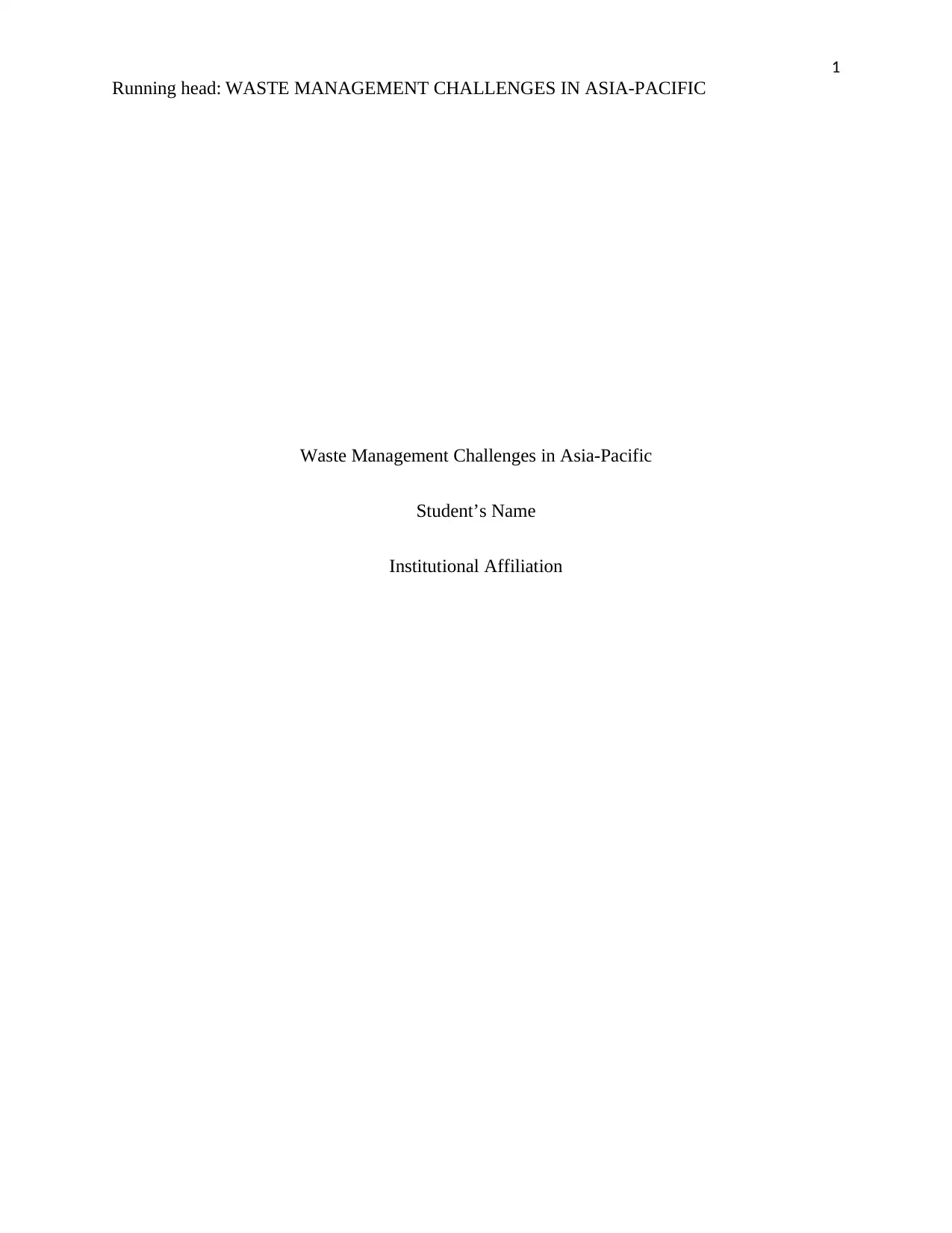
1
Running head: WASTE MANAGEMENT CHALLENGES IN ASIA-PACIFIC
Waste Management Challenges in Asia-Pacific
Student’s Name
Institutional Affiliation
Running head: WASTE MANAGEMENT CHALLENGES IN ASIA-PACIFIC
Waste Management Challenges in Asia-Pacific
Student’s Name
Institutional Affiliation
Paraphrase This Document
Need a fresh take? Get an instant paraphrase of this document with our AI Paraphraser

2
WASTE MANAGEMENT CHALLENGES IN ASIA-PACIFIC
Introduction
There are various strategies which can be practiced in the strive to achieve the
Sustainable Development Goals. The achievement of Sustainable Development Goals would
bring about a positive impact on the entire human race and the environment. In Asia-Pacific, the
issue of solid waste management is a challenge. Management of solid waste is a significant
concern which, if successively achieved, would lead to the attainment of several sustainable
development goals. The solution to this challenge in Asia-Pacific is the project known as
Integration of Resources and Recovery Center, which uses low-cost strategies and the local
community to deal with urban solid waste. The local community would be encouraged in the
management of solid waste through awareness building, provision of jobs, and establishment of
laws and policies which compel them to be responsible for waste management.
What is the Problem Being Investigated?
The developing countries in Asia-Pacific are facing the challenge of solid waste
management. This challenge is mostly affecting secondary cities and other small towns.
Williams (2017) argues that these developing countries are having an increased rate of
urbanization, which is attracting a high population. The result of the increase of people is the
increment in the accumulation of solid wastes in urban areas. Marine debris are also an issue in
these countries (McIlgorm, Campbell and Rule, 2011). However, these countries have a
challenge in obtaining waste management solutions which are cheap and which make use of
locally available resources (Williams, 2017). The solution which has been used in many of these
cities and towns is the partial collection, transportation, and disposal of the solid waste into
landfills, as well as dumpsites. This solution is what Williams (2017) calls the end-of-pipe
solution, which is not effective since it only collects approximately 50-60% of the solid waste in
WASTE MANAGEMENT CHALLENGES IN ASIA-PACIFIC
Introduction
There are various strategies which can be practiced in the strive to achieve the
Sustainable Development Goals. The achievement of Sustainable Development Goals would
bring about a positive impact on the entire human race and the environment. In Asia-Pacific, the
issue of solid waste management is a challenge. Management of solid waste is a significant
concern which, if successively achieved, would lead to the attainment of several sustainable
development goals. The solution to this challenge in Asia-Pacific is the project known as
Integration of Resources and Recovery Center, which uses low-cost strategies and the local
community to deal with urban solid waste. The local community would be encouraged in the
management of solid waste through awareness building, provision of jobs, and establishment of
laws and policies which compel them to be responsible for waste management.
What is the Problem Being Investigated?
The developing countries in Asia-Pacific are facing the challenge of solid waste
management. This challenge is mostly affecting secondary cities and other small towns.
Williams (2017) argues that these developing countries are having an increased rate of
urbanization, which is attracting a high population. The result of the increase of people is the
increment in the accumulation of solid wastes in urban areas. Marine debris are also an issue in
these countries (McIlgorm, Campbell and Rule, 2011). However, these countries have a
challenge in obtaining waste management solutions which are cheap and which make use of
locally available resources (Williams, 2017). The solution which has been used in many of these
cities and towns is the partial collection, transportation, and disposal of the solid waste into
landfills, as well as dumpsites. This solution is what Williams (2017) calls the end-of-pipe
solution, which is not effective since it only collects approximately 50-60% of the solid waste in
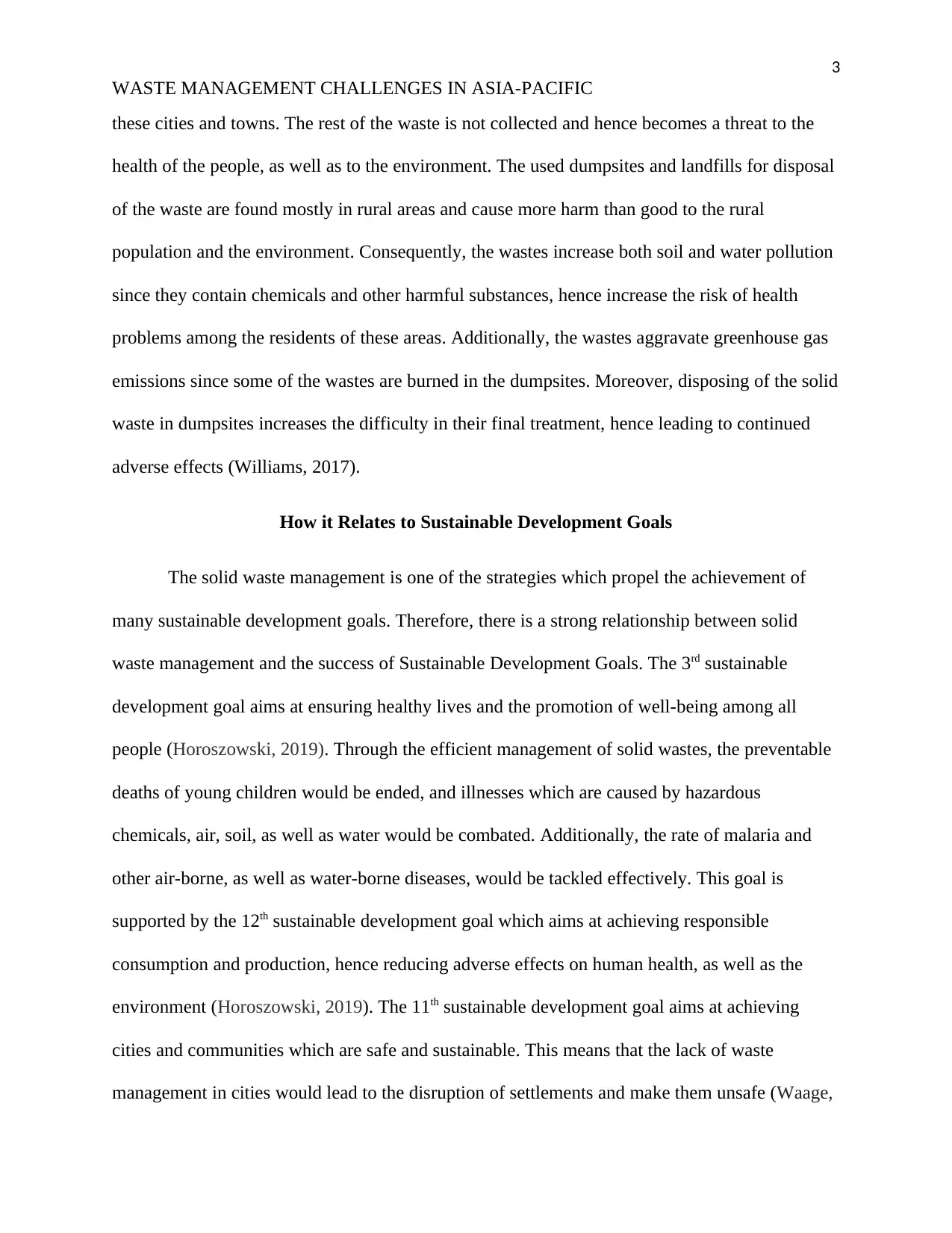
3
WASTE MANAGEMENT CHALLENGES IN ASIA-PACIFIC
these cities and towns. The rest of the waste is not collected and hence becomes a threat to the
health of the people, as well as to the environment. The used dumpsites and landfills for disposal
of the waste are found mostly in rural areas and cause more harm than good to the rural
population and the environment. Consequently, the wastes increase both soil and water pollution
since they contain chemicals and other harmful substances, hence increase the risk of health
problems among the residents of these areas. Additionally, the wastes aggravate greenhouse gas
emissions since some of the wastes are burned in the dumpsites. Moreover, disposing of the solid
waste in dumpsites increases the difficulty in their final treatment, hence leading to continued
adverse effects (Williams, 2017).
How it Relates to Sustainable Development Goals
The solid waste management is one of the strategies which propel the achievement of
many sustainable development goals. Therefore, there is a strong relationship between solid
waste management and the success of Sustainable Development Goals. The 3rd sustainable
development goal aims at ensuring healthy lives and the promotion of well-being among all
people (Horoszowski, 2019). Through the efficient management of solid wastes, the preventable
deaths of young children would be ended, and illnesses which are caused by hazardous
chemicals, air, soil, as well as water would be combated. Additionally, the rate of malaria and
other air-borne, as well as water-borne diseases, would be tackled effectively. This goal is
supported by the 12th sustainable development goal which aims at achieving responsible
consumption and production, hence reducing adverse effects on human health, as well as the
environment (Horoszowski, 2019). The 11th sustainable development goal aims at achieving
cities and communities which are safe and sustainable. This means that the lack of waste
management in cities would lead to the disruption of settlements and make them unsafe (Waage,
WASTE MANAGEMENT CHALLENGES IN ASIA-PACIFIC
these cities and towns. The rest of the waste is not collected and hence becomes a threat to the
health of the people, as well as to the environment. The used dumpsites and landfills for disposal
of the waste are found mostly in rural areas and cause more harm than good to the rural
population and the environment. Consequently, the wastes increase both soil and water pollution
since they contain chemicals and other harmful substances, hence increase the risk of health
problems among the residents of these areas. Additionally, the wastes aggravate greenhouse gas
emissions since some of the wastes are burned in the dumpsites. Moreover, disposing of the solid
waste in dumpsites increases the difficulty in their final treatment, hence leading to continued
adverse effects (Williams, 2017).
How it Relates to Sustainable Development Goals
The solid waste management is one of the strategies which propel the achievement of
many sustainable development goals. Therefore, there is a strong relationship between solid
waste management and the success of Sustainable Development Goals. The 3rd sustainable
development goal aims at ensuring healthy lives and the promotion of well-being among all
people (Horoszowski, 2019). Through the efficient management of solid wastes, the preventable
deaths of young children would be ended, and illnesses which are caused by hazardous
chemicals, air, soil, as well as water would be combated. Additionally, the rate of malaria and
other air-borne, as well as water-borne diseases, would be tackled effectively. This goal is
supported by the 12th sustainable development goal which aims at achieving responsible
consumption and production, hence reducing adverse effects on human health, as well as the
environment (Horoszowski, 2019). The 11th sustainable development goal aims at achieving
cities and communities which are safe and sustainable. This means that the lack of waste
management in cities would lead to the disruption of settlements and make them unsafe (Waage,
⊘ This is a preview!⊘
Do you want full access?
Subscribe today to unlock all pages.

Trusted by 1+ million students worldwide
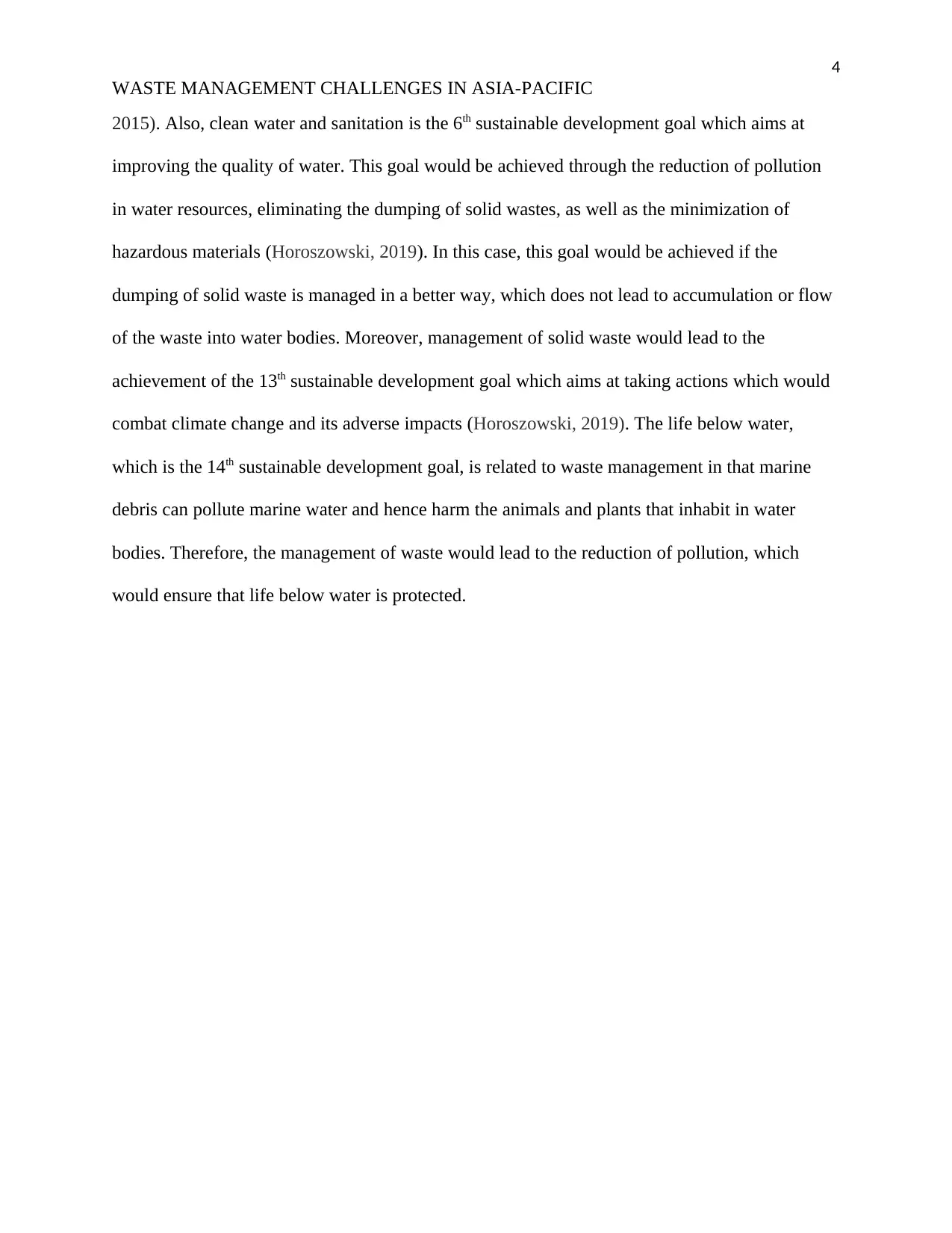
4
WASTE MANAGEMENT CHALLENGES IN ASIA-PACIFIC
2015). Also, clean water and sanitation is the 6th sustainable development goal which aims at
improving the quality of water. This goal would be achieved through the reduction of pollution
in water resources, eliminating the dumping of solid wastes, as well as the minimization of
hazardous materials (Horoszowski, 2019). In this case, this goal would be achieved if the
dumping of solid waste is managed in a better way, which does not lead to accumulation or flow
of the waste into water bodies. Moreover, management of solid waste would lead to the
achievement of the 13th sustainable development goal which aims at taking actions which would
combat climate change and its adverse impacts (Horoszowski, 2019). The life below water,
which is the 14th sustainable development goal, is related to waste management in that marine
debris can pollute marine water and hence harm the animals and plants that inhabit in water
bodies. Therefore, the management of waste would lead to the reduction of pollution, which
would ensure that life below water is protected.
WASTE MANAGEMENT CHALLENGES IN ASIA-PACIFIC
2015). Also, clean water and sanitation is the 6th sustainable development goal which aims at
improving the quality of water. This goal would be achieved through the reduction of pollution
in water resources, eliminating the dumping of solid wastes, as well as the minimization of
hazardous materials (Horoszowski, 2019). In this case, this goal would be achieved if the
dumping of solid waste is managed in a better way, which does not lead to accumulation or flow
of the waste into water bodies. Moreover, management of solid waste would lead to the
achievement of the 13th sustainable development goal which aims at taking actions which would
combat climate change and its adverse impacts (Horoszowski, 2019). The life below water,
which is the 14th sustainable development goal, is related to waste management in that marine
debris can pollute marine water and hence harm the animals and plants that inhabit in water
bodies. Therefore, the management of waste would lead to the reduction of pollution, which
would ensure that life below water is protected.
Paraphrase This Document
Need a fresh take? Get an instant paraphrase of this document with our AI Paraphraser
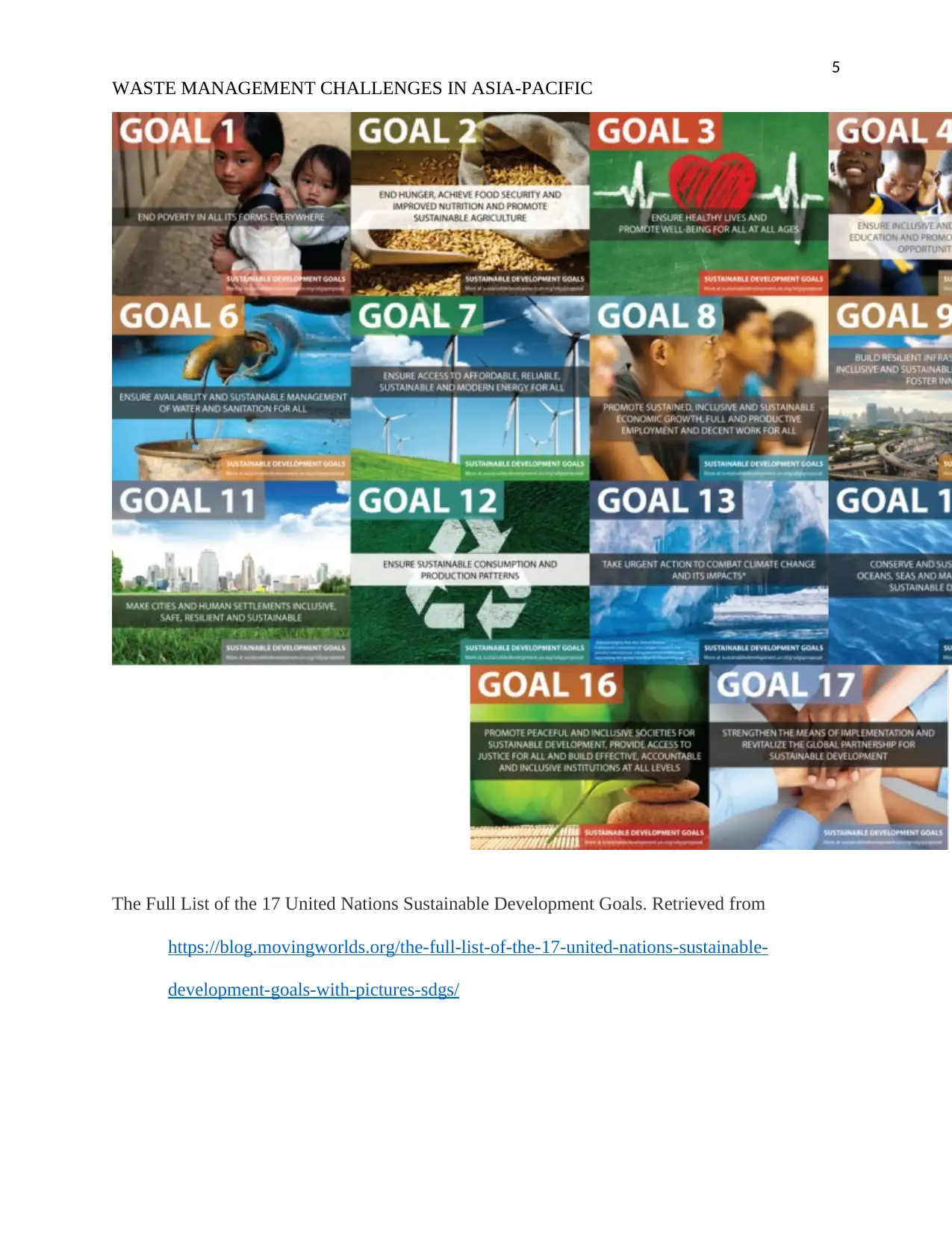
5
WASTE MANAGEMENT CHALLENGES IN ASIA-PACIFIC
The Full List of the 17 United Nations Sustainable Development Goals. Retrieved from
https://blog.movingworlds.org/the-full-list-of-the-17-united-nations-sustainable-
development-goals-with-pictures-sdgs/
WASTE MANAGEMENT CHALLENGES IN ASIA-PACIFIC
The Full List of the 17 United Nations Sustainable Development Goals. Retrieved from
https://blog.movingworlds.org/the-full-list-of-the-17-united-nations-sustainable-
development-goals-with-pictures-sdgs/

6
WASTE MANAGEMENT CHALLENGES IN ASIA-PACIFIC
What is the Proposed Solution?
The solution to the management of solid waste in secondary cities and small towns in
Asia-Pacific involves the use of cost-effective and an environmentally sustainable approach,
including the participation of local community and adoption of reduce, reuse, and recycle
practices (Williams, 2017., Pariatamby and Fauziah, 2014). This solution was proposed through
the development of a project known as Integrated Resource Recovery Centers by the partnership
of the United Nations Economic and Social Commission for Asia and the Pacific and the Waste
Concern. The average expenditure of the collection, transportation, and disposal of solid waste in
municipals was 20% of their total income (Williams, 2017). This expenditure is high,
considering the total revenue that the municipals accrue every year. Therefore, the
implementation of the Integrated Resource Recovery Centers approaches would reduce this
expenditure. These approaches aimed at converting organic components of the solid waste into
compost through the use of aerobic composting processes. Anaerobic digestion would also be
used in bio-digesters to produce biogas, which would serve significantly in the generation of
electricity (Williams, 2017). Also, the Integrated Resources Recovery Centers would set up
coco-peat filters for fecal sludge, which would filter fecal water to excellent quality and hence be
discharged into the soil to recharge groundwater. Moreover, the urban solid waste would be
managed through the recovery and sorting of materials which are recyclable such as glasses,
plastics, papers, and metals and hence be sold in the market. Also, combustible waste materials
would be converted into refuse-derived fuel and used cooking oil would be converted into
biodiesel (Williams, 2017). These solutions would be cost-effective since they do not consume
much of the municipal income. The adverse effects of solid waste would also be avoided through
the implementation of these approaches. Additionally, the urban population would benefit from
WASTE MANAGEMENT CHALLENGES IN ASIA-PACIFIC
What is the Proposed Solution?
The solution to the management of solid waste in secondary cities and small towns in
Asia-Pacific involves the use of cost-effective and an environmentally sustainable approach,
including the participation of local community and adoption of reduce, reuse, and recycle
practices (Williams, 2017., Pariatamby and Fauziah, 2014). This solution was proposed through
the development of a project known as Integrated Resource Recovery Centers by the partnership
of the United Nations Economic and Social Commission for Asia and the Pacific and the Waste
Concern. The average expenditure of the collection, transportation, and disposal of solid waste in
municipals was 20% of their total income (Williams, 2017). This expenditure is high,
considering the total revenue that the municipals accrue every year. Therefore, the
implementation of the Integrated Resource Recovery Centers approaches would reduce this
expenditure. These approaches aimed at converting organic components of the solid waste into
compost through the use of aerobic composting processes. Anaerobic digestion would also be
used in bio-digesters to produce biogas, which would serve significantly in the generation of
electricity (Williams, 2017). Also, the Integrated Resources Recovery Centers would set up
coco-peat filters for fecal sludge, which would filter fecal water to excellent quality and hence be
discharged into the soil to recharge groundwater. Moreover, the urban solid waste would be
managed through the recovery and sorting of materials which are recyclable such as glasses,
plastics, papers, and metals and hence be sold in the market. Also, combustible waste materials
would be converted into refuse-derived fuel and used cooking oil would be converted into
biodiesel (Williams, 2017). These solutions would be cost-effective since they do not consume
much of the municipal income. The adverse effects of solid waste would also be avoided through
the implementation of these approaches. Additionally, the urban population would benefit from
⊘ This is a preview!⊘
Do you want full access?
Subscribe today to unlock all pages.

Trusted by 1+ million students worldwide
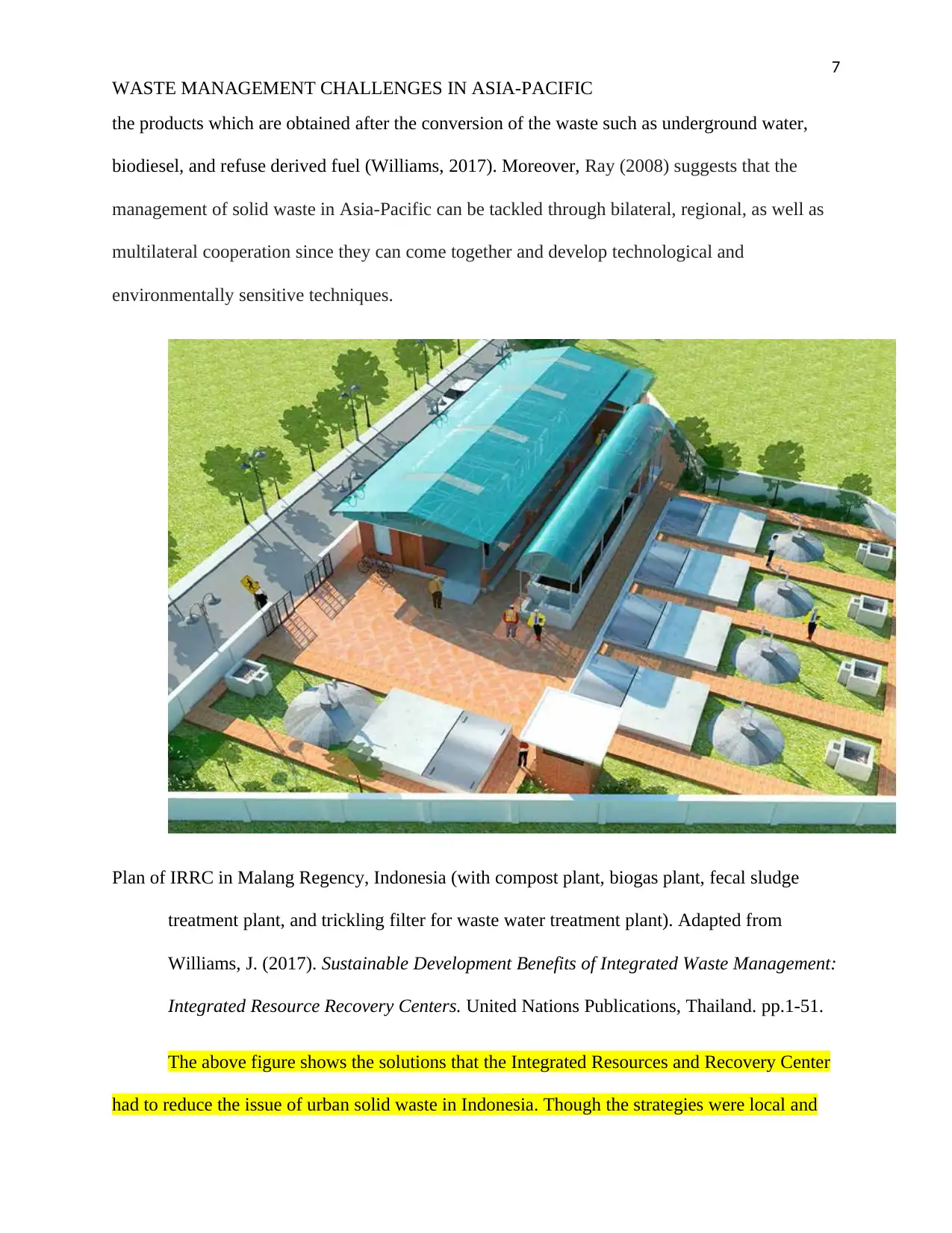
7
WASTE MANAGEMENT CHALLENGES IN ASIA-PACIFIC
the products which are obtained after the conversion of the waste such as underground water,
biodiesel, and refuse derived fuel (Williams, 2017). Moreover, Ray (2008) suggests that the
management of solid waste in Asia-Pacific can be tackled through bilateral, regional, as well as
multilateral cooperation since they can come together and develop technological and
environmentally sensitive techniques.
Plan of IRRC in Malang Regency, Indonesia (with compost plant, biogas plant, fecal sludge
treatment plant, and trickling filter for waste water treatment plant). Adapted from
Williams, J. (2017). Sustainable Development Benefits of Integrated Waste Management:
Integrated Resource Recovery Centers. United Nations Publications, Thailand. pp.1-51.
The above figure shows the solutions that the Integrated Resources and Recovery Center
had to reduce the issue of urban solid waste in Indonesia. Though the strategies were local and
WASTE MANAGEMENT CHALLENGES IN ASIA-PACIFIC
the products which are obtained after the conversion of the waste such as underground water,
biodiesel, and refuse derived fuel (Williams, 2017). Moreover, Ray (2008) suggests that the
management of solid waste in Asia-Pacific can be tackled through bilateral, regional, as well as
multilateral cooperation since they can come together and develop technological and
environmentally sensitive techniques.
Plan of IRRC in Malang Regency, Indonesia (with compost plant, biogas plant, fecal sludge
treatment plant, and trickling filter for waste water treatment plant). Adapted from
Williams, J. (2017). Sustainable Development Benefits of Integrated Waste Management:
Integrated Resource Recovery Centers. United Nations Publications, Thailand. pp.1-51.
The above figure shows the solutions that the Integrated Resources and Recovery Center
had to reduce the issue of urban solid waste in Indonesia. Though the strategies were local and
Paraphrase This Document
Need a fresh take? Get an instant paraphrase of this document with our AI Paraphraser
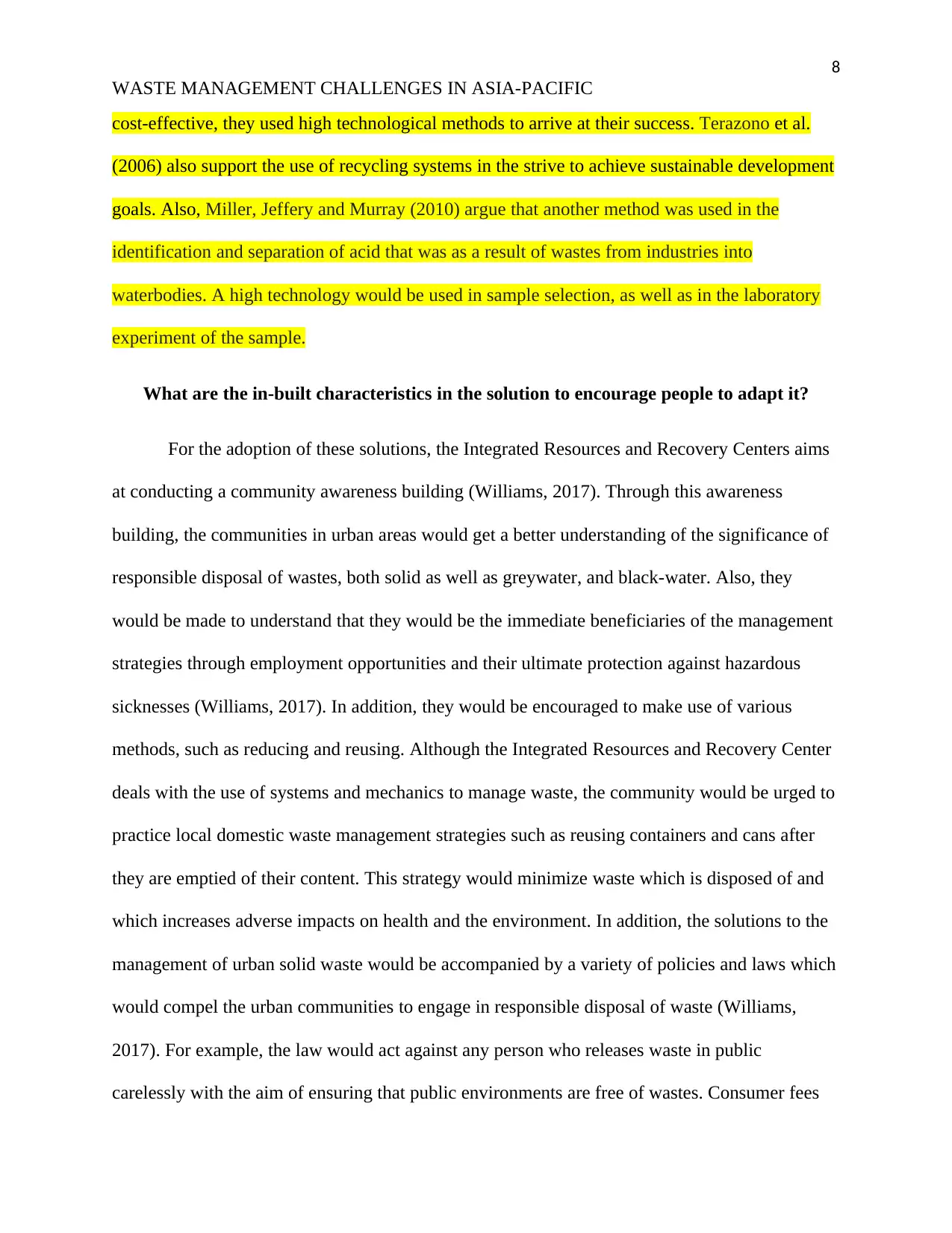
8
WASTE MANAGEMENT CHALLENGES IN ASIA-PACIFIC
cost-effective, they used high technological methods to arrive at their success. Terazono et al.
(2006) also support the use of recycling systems in the strive to achieve sustainable development
goals. Also, Miller, Jeffery and Murray (2010) argue that another method was used in the
identification and separation of acid that was as a result of wastes from industries into
waterbodies. A high technology would be used in sample selection, as well as in the laboratory
experiment of the sample.
What are the in-built characteristics in the solution to encourage people to adapt it?
For the adoption of these solutions, the Integrated Resources and Recovery Centers aims
at conducting a community awareness building (Williams, 2017). Through this awareness
building, the communities in urban areas would get a better understanding of the significance of
responsible disposal of wastes, both solid as well as greywater, and black-water. Also, they
would be made to understand that they would be the immediate beneficiaries of the management
strategies through employment opportunities and their ultimate protection against hazardous
sicknesses (Williams, 2017). In addition, they would be encouraged to make use of various
methods, such as reducing and reusing. Although the Integrated Resources and Recovery Center
deals with the use of systems and mechanics to manage waste, the community would be urged to
practice local domestic waste management strategies such as reusing containers and cans after
they are emptied of their content. This strategy would minimize waste which is disposed of and
which increases adverse impacts on health and the environment. In addition, the solutions to the
management of urban solid waste would be accompanied by a variety of policies and laws which
would compel the urban communities to engage in responsible disposal of waste (Williams,
2017). For example, the law would act against any person who releases waste in public
carelessly with the aim of ensuring that public environments are free of wastes. Consumer fees
WASTE MANAGEMENT CHALLENGES IN ASIA-PACIFIC
cost-effective, they used high technological methods to arrive at their success. Terazono et al.
(2006) also support the use of recycling systems in the strive to achieve sustainable development
goals. Also, Miller, Jeffery and Murray (2010) argue that another method was used in the
identification and separation of acid that was as a result of wastes from industries into
waterbodies. A high technology would be used in sample selection, as well as in the laboratory
experiment of the sample.
What are the in-built characteristics in the solution to encourage people to adapt it?
For the adoption of these solutions, the Integrated Resources and Recovery Centers aims
at conducting a community awareness building (Williams, 2017). Through this awareness
building, the communities in urban areas would get a better understanding of the significance of
responsible disposal of wastes, both solid as well as greywater, and black-water. Also, they
would be made to understand that they would be the immediate beneficiaries of the management
strategies through employment opportunities and their ultimate protection against hazardous
sicknesses (Williams, 2017). In addition, they would be encouraged to make use of various
methods, such as reducing and reusing. Although the Integrated Resources and Recovery Center
deals with the use of systems and mechanics to manage waste, the community would be urged to
practice local domestic waste management strategies such as reusing containers and cans after
they are emptied of their content. This strategy would minimize waste which is disposed of and
which increases adverse impacts on health and the environment. In addition, the solutions to the
management of urban solid waste would be accompanied by a variety of policies and laws which
would compel the urban communities to engage in responsible disposal of waste (Williams,
2017). For example, the law would act against any person who releases waste in public
carelessly with the aim of ensuring that public environments are free of wastes. Consumer fees
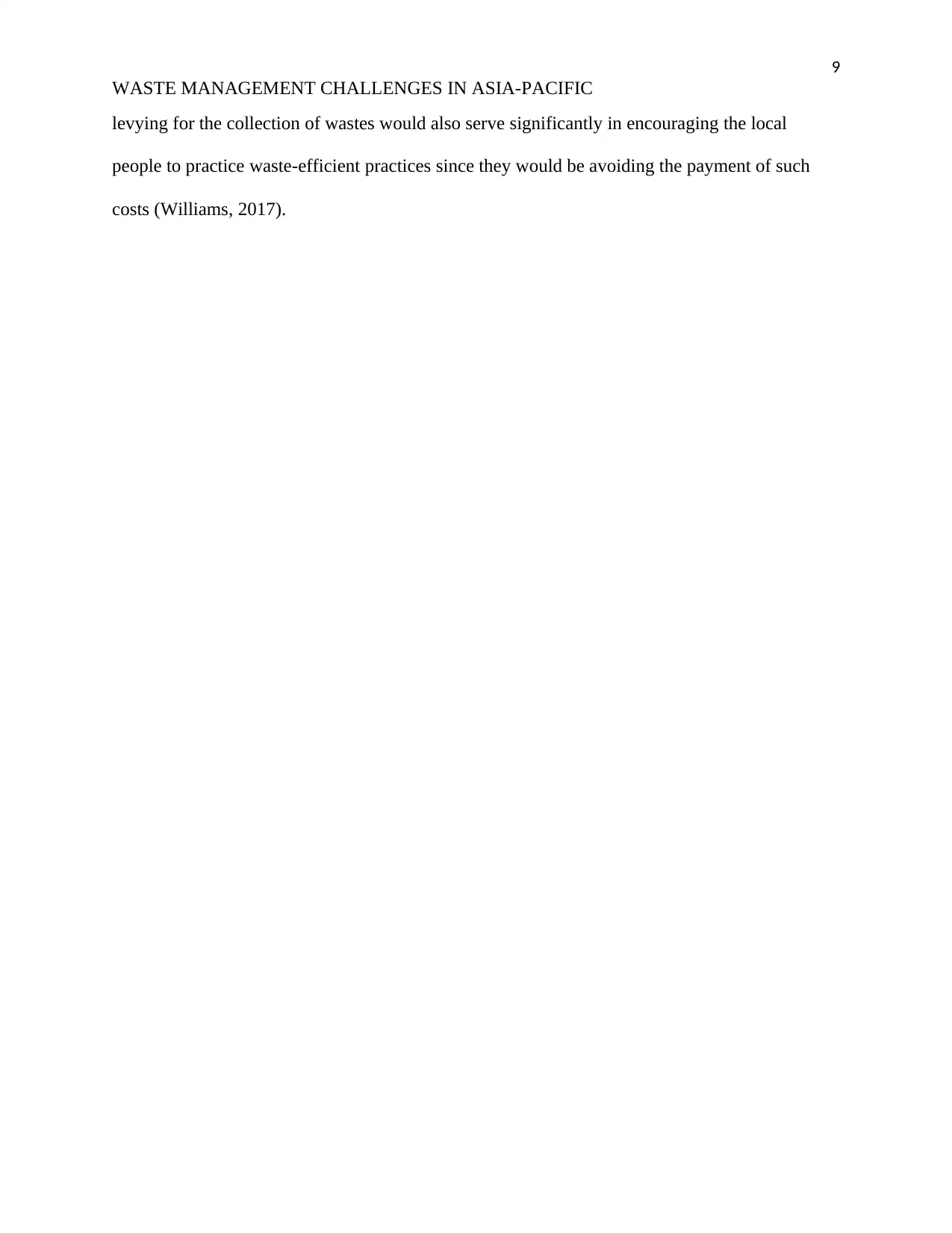
9
WASTE MANAGEMENT CHALLENGES IN ASIA-PACIFIC
levying for the collection of wastes would also serve significantly in encouraging the local
people to practice waste-efficient practices since they would be avoiding the payment of such
costs (Williams, 2017).
WASTE MANAGEMENT CHALLENGES IN ASIA-PACIFIC
levying for the collection of wastes would also serve significantly in encouraging the local
people to practice waste-efficient practices since they would be avoiding the payment of such
costs (Williams, 2017).
⊘ This is a preview!⊘
Do you want full access?
Subscribe today to unlock all pages.

Trusted by 1+ million students worldwide

10
WASTE MANAGEMENT CHALLENGES IN ASIA-PACIFIC
References
Horoszowski, M. (2019, January 23). The Full List of the 17 United Nations Sustainable
Development Goals. Retrieved from https://blog.movingworlds.org/the-full-list-of-the-
17-united-nations-sustainable-development-goals-with-pictures-sdgs/
McIlgorm, A., Campbell, H. F., & Rule, M. J. (2011). The economic cost and control of marine
debris damage in the Asia-Pacific region. Ocean & Coastal Management, 54(9), 643-
651.
Miller, S. D., Jeffery, J. J., & Murray, G. S. C. (2010). Identification and management of acid
generating mine wastes-procedures and practices in south-east Asia and the Pacific
regions. International journal of mine water, 9(1-4), 57-67.
Pariatamby, A., & Fauziah, S. H. (2014). Sustainable 3R practice in the Asia and Pacific
Regions: the challenges and issues. In Municipal Solid Waste Management in Asia and
the Pacific Islands (pp. 15-40). Springer, Singapore.
Ray, A. (2008). Waste management in developing Asia: can trade and cooperation help?. The
Journal of Environment & Development, 17(1), 3-25.
Terazono, A., Murakami, S., Abe, N., Inanc, B., Moriguchi, Y., Sakai, S. I., ... & Wong, M. H.
(2006). Current status and research on E-waste issues in Asia. Journal of Material Cycles
and Waste Management, 8(1), 1-12.
Waage, J., Yap, C., Bell, S., Levy, C., Mace, G., Pegram, T., ... & Mayhew, S. (2015).
Governing the UN Sustainable Development Goals: interactions, infrastructures, and
institutions. The Lancet Global Health, 3(5), e251-e252.
WASTE MANAGEMENT CHALLENGES IN ASIA-PACIFIC
References
Horoszowski, M. (2019, January 23). The Full List of the 17 United Nations Sustainable
Development Goals. Retrieved from https://blog.movingworlds.org/the-full-list-of-the-
17-united-nations-sustainable-development-goals-with-pictures-sdgs/
McIlgorm, A., Campbell, H. F., & Rule, M. J. (2011). The economic cost and control of marine
debris damage in the Asia-Pacific region. Ocean & Coastal Management, 54(9), 643-
651.
Miller, S. D., Jeffery, J. J., & Murray, G. S. C. (2010). Identification and management of acid
generating mine wastes-procedures and practices in south-east Asia and the Pacific
regions. International journal of mine water, 9(1-4), 57-67.
Pariatamby, A., & Fauziah, S. H. (2014). Sustainable 3R practice in the Asia and Pacific
Regions: the challenges and issues. In Municipal Solid Waste Management in Asia and
the Pacific Islands (pp. 15-40). Springer, Singapore.
Ray, A. (2008). Waste management in developing Asia: can trade and cooperation help?. The
Journal of Environment & Development, 17(1), 3-25.
Terazono, A., Murakami, S., Abe, N., Inanc, B., Moriguchi, Y., Sakai, S. I., ... & Wong, M. H.
(2006). Current status and research on E-waste issues in Asia. Journal of Material Cycles
and Waste Management, 8(1), 1-12.
Waage, J., Yap, C., Bell, S., Levy, C., Mace, G., Pegram, T., ... & Mayhew, S. (2015).
Governing the UN Sustainable Development Goals: interactions, infrastructures, and
institutions. The Lancet Global Health, 3(5), e251-e252.
Paraphrase This Document
Need a fresh take? Get an instant paraphrase of this document with our AI Paraphraser

11
WASTE MANAGEMENT CHALLENGES IN ASIA-PACIFIC
Williams, J. (2017). Sustainable Development Benefits of Integrated Waste Management:
Integrated Resource Recovery Centers. United Nations Publications, Thailand. pp.1-51.
WASTE MANAGEMENT CHALLENGES IN ASIA-PACIFIC
Williams, J. (2017). Sustainable Development Benefits of Integrated Waste Management:
Integrated Resource Recovery Centers. United Nations Publications, Thailand. pp.1-51.
1 out of 11
Related Documents
Your All-in-One AI-Powered Toolkit for Academic Success.
+13062052269
info@desklib.com
Available 24*7 on WhatsApp / Email
![[object Object]](/_next/static/media/star-bottom.7253800d.svg)
Unlock your academic potential
Copyright © 2020–2025 A2Z Services. All Rights Reserved. Developed and managed by ZUCOL.




